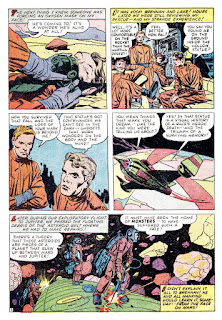Race For the Moon, a scant three issues from Harvey Comics, is something beloved by me as relics of my pre-teen years. Especially issues numbers 2 and 3, illustrated, and presumably written, by Jack Kirby, perhaps with his partner, Joe Simon. The stories showed how Kirby, later famous for his epics stretching over many issues of comic books, could also craft a story of a few pages. “The Face on Mars” by Kirby is what I immediately thought of when I saw the NASA photo of a face on Mars. (Note: I am a skeptic by nature, and I also know about pattern recognition. Random objects can contain faces, but by coincidence. It’s the way our brains are wired.)
But, I am here to talk about Kirby’s big Martian face. A Mars explorer goes in through an eyehole and is given a lifelike vision of the former occupants of Mars. It is drawn using the Kirby dynamics (action, and science fiction devices that he did so well) and inked by Al Williamson. Their drawing styles may have been different, but in this way they complemented each other.
Face front, true Martian face believers and even non-believers! From Race For the Moon #2 (1958).







I've wondered about Williamson's inking of Kirby's pencils. In the case of another story, “Island in the Sky”, it really looked to me as if Williamson had added little-or-no polish where Kirby had expected it of the inker. Here, the end result has very little apparent polish; it is almost like pure Kirby.
ReplyDeleteThe story itself reads like a prologue. Perhaps the writer imagined later picking-up the threads and continuing. Or perhaps the writer had the idea for the beginning of a story but couldn't think of where to go with it.
A further development of this story could draw profitably upon mythology. As it happens, giants figure into myths found around the world of a era before a great flood. The tales of the great flood may have in part derived from retellings of stories of often rapid rises in sea levels as the most recent ice age came to an end.
But it was somewhat cheesy to have a character other than the main character presume, at the end of this story, that the destruction of the hypothesized planet were because of the monstrosity of its inhabitants. In most tellings, Krypton exploded simply as a matter of bad geophysical luck.
The story is definitely an old saw -- visions of the brave but eventually tragic war of planets -- but it's lifted by Kirby's great visual imagination. The robots (?) and their ships are awesome. The rockets and machinery are all vintage Kirby.
ReplyDeleteI do love the splash where our explorers are living in tents on the surface!
Brian, camping on Mars...bring insulated blankets. And a supply of oxygen.
ReplyDeleteDaniel, Kirby did several stories for Harvey Comics that look like they could use expansion, but were reduced to 5 or 6 pages. I recall an interview with Williamson where he said he was asked to do the inking, but I don't think it was by Kirby. Kirby didn't have anything bad (usually) to say about people who did inking, because as I recall he thought of the inkers as having families they needed to support. Kirby was a good human being in that way, but must have winced sometimes when looking at the finished versions of some of his stories.
ReplyDeleteI have also heard that when jobs were tight after most comic book companies had crashed in the mid-'50s, he did stories for DC's mystery comics that were inked by his wife. Or at least he had her outline everything in pen, then he'd go back in with a brush for thick and thin lines and black areas.